|
|
Ayrshire

|
|
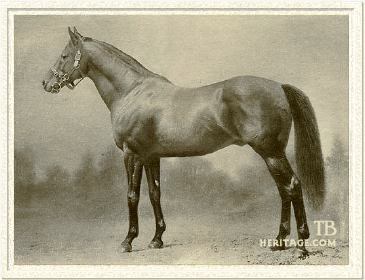 |
|
|
Ayrshire was the first of seven classic winners for his breeder and owner, William Cavendish-Bentinck, 6th Duke of Portland, later and forever known as the owner of the undefeated racehorse and great stallion, St. Simon. Ayrshire, who was by Hampton, was one of three top winners bred at Welbeck Stud who were not by St. Simon, the other two being the champion two year old filly Modwena and her brother, the classic-winner and champion Donovan, who were by Galopin.

One of Portland's favorite phrases was "Luck's all," a quote from Byron, followed by his own observation, "...especially novice's luck." And from the first he seemed to have uncanny fortune with his purchase of prospective broodmares. He bought the good race mare Mowerina as his first prospective broodmare at the age of 5 in 1882, and she became dam of the aforementioned Modwena and Donovan, as well as the champion two year old filly Semolina and the good racehorse Raeburn, the latter two by St. Simon. Several of the mares he bought when developing his stud were of no account on the track, but with the advice of some of the best horsemen of the 1880s, he was able to build an enviable group of producers. Miss Middlewick, by Scottish Chief, was unraced, and Tact and Gravity (both by Wisdom), and Miss Mildred (by Melton) were winless. Yet from this group of mares came Mrs. Butterwick, Amiable, and La Roche, all Oaks winners, and the latter two champion three year old fillies, and William the Third, winner of the Ascot Gold Cup and champion older horse in England.
Then there was Atalanta, a beautifully bred filly whose sire, Galopin and damsire, Thormanby, were both Derby winners, and whose female family traced to the great race mare Bee's Wing. |
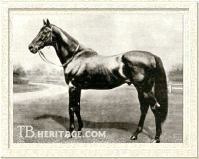
Hampton, a top stayer and good weight carrier, and leading sire in England
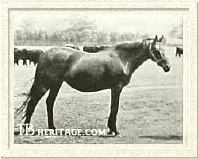
Atalanta proved to be a good producer
| |
Atalanta had been injured when a foal, and could scarcely stand when her dam, Feronia, was purchased by Lord Rosslyn. Portland later said in his Memoirs that "It was all plain sailing as to Feronia, but the crux came when the price had to be settled for the foal [Atalanta]...A lot of bargaining took place, and it was understood that Rosslyn eventually paid 7s. 6d. in cash, adding a wheelbarrow, and a matrimonial engagement for Uncle Clayton's [Feronia's seller] prize sow. I hardly supposed that the dam of a future Derby winner ever before or afterwards changed hands under such peculiar circumstances!"
Portland bought Atalanta after she won the Great Eastern Handicap, and while in trials she showed herself "to be about as good as Mowerina," she never won a race for the Duke, although she did place third to Lowland Chief and Vibration in the Steward's Cup at Goodwood in 1882, after which she was retired to the Portland stud. In addition to Ayrshire, she produced Flying Footstep, third dam of the great Italian sire Havresac II; Caithness, third dam of the great race filly Maskette and tail-female ancestress of some other good American racehorses; Walmsgate, a successful sire of hunters and steeplechasers in Ireland, including the Grand National winner Jerry M; Melanion, who got some good horses in England and was later a decent sire in Italy; and Ayrshire's brother, the somewhat unsound Troon, who won the St. James' Palace Stakes and other good races, killed at age four when he slipped in a race and fell into the rails.
|
Atalanta was first sent to Doncaster, and produced Flying Footstep to him in 1884. That year she was sent to Hampton, who standing at stud near Newmarket. Hampton had been a tough racehorse in his day, winning over twenty races, and proved himself to be a fine Cup horse, with victories in both the Goodwood and Doncaster Cups and seventeen other races. Hampton was by Newminster's classic-winning son, Lord Clifden and from the family of Queen Mary, which had produced classic winners Blink Bonny, Blair Athol, Sir Bevys, and Caller Ou. This breeding produced a strong, handsome bay colt Portland named Ayrshire.
Ayrshire on the Turf
The crop of 1885 was a strong one, and Ayrshire's contemporaries included two talented fillies, Briar-root and Seabreeze, as well as the brilliant Hermit colt Friar's Balsam. Ayrshire made his debut in the Whitsuntide Plate at the Manchester Whitsuntide meeting, and came in a neck and a head in third place, the race being won by Briar-root, a daughter of Springfield. Ayrshire ran next at Ascot, in the important New Stakes, but was no match for Friar's Balsam, a colt who would sweep through his juvenile year unbeaten in seven starts. Friar's Balsam won by three lengths from Seabreeze, a beautifully bred daughter of Isonomy from Hermit's classic-winning daughter St. Marguerite. Ayrshire finished a non-menacing third.
Thereafter, Ayrshire reeled off five consecutive victories, including the Prince of Wales Stakes at Goodwood and the Champagne Stakes at Doncaster. The Duke's colt was in top form, but unfortunately suffered a minor leg injury in the latter race, and was put away for the year, leaving the important juvenile races of the autumn, including the Middle Park Plate, to the mercy of Friar's Balsam. The Duke was philosophical about the disappointing injury and later said Ayrshire might not have had much hope of beating the brilliant Friar's Balsam in any of the races where they might have met.
Ayrshire made his debut as a three-year-old at Newmarket in the Riddlesworth Post Stakes. It could hardly be classified as a race, as Ayrshire had but a solitary, overmatched opponent whom he beat by twenty lengths. The Two Thousand Guineas was next on the agenda, and a meeting with the formidable Friar's Balsam. The race was an eventful one for that colt. It turned out that the Hermit colt had stepped on a dangling rein not long before the Guineas and wrenched his jaw. An abcess developed which his trainer, the normally astute John Porter, failed to detect. The Duke of Portland suspected something might be wrong, as he strolled about to have a peek at the competition, and noticed blood on Friar's Balsam's manger. Pointing this out to Porter, it was dismissed as nothing of consequence. How wrong Porter was. During the running of the race, Ayrshire sailed along to an easy victory over his stablemate Johnny Morgan, while poor Friar's Balsam suffered tremendously. The abcess burst during the stress of running the race and he finished far down the course. It was a sad sight to see the courageous colt return to be unsaddled with blood streaming from his mouth. Friar's Balsam was never quite the same colt again, though he did win the Champion Stakes at four. But his classic season was all but ruined.
With Friar's Balsam out of the way, the Derby was pretty much at the mercy of the Duke colt. That was the way it turned out. Ayrshire was always well placed under jockey Fred Barrett and moved to an easy lead past Tattenham Corner. He won by two comfortable lengths from Crowberry, despite swerving near the finish post when Barrett gave his mount a touch with his left spur.
At Doncaster, Ayrshire ran a dismal race, coming in sixth to Oaks winner Seabreeze. Cut back from the 1-3/4 miles of the St. Leger to seven furlongs for the Lancashire Plate, Ayrshire ran much better, going under by less than a length to Seabreeze, with Friar's Balsam, on the comeback trail from that bloody burst abcess of the spring, finishing unplaced. In this race, Ayrshire carried 138 pounds, three more than the filly. Ayrshire closed out his three-year-old season with an easy victory over the fine Galopin colt, Grafton, in the Great Foal Stakes at Newmarket.
|
|
Ayrshire's Race Record
|
| Year |
Age |
Starts |
1st |
2nd |
3rd |
Unplaced |
| 1887 |
2 |
7 |
5 |
0 |
2 |
0 |
| 1888 |
3 |
6 |
4 |
1 |
0 |
1 |
| 1889 |
4 |
3 |
2 |
0 |
1 |
0 |
| Total |
-- |
16 |
11 |
1 |
3 |
1 |
| |
As a four-year-old, Ayrshire made only three starts. In the Kempton Park Royal Stakes, Ayrshire lugged 141 pounds to victory, defeating Seabreeze, under 138 pounds, by three parts of a length. His next start was for the rich Eclipse Stakes at Sandowne Park. With 142 pounds up, Ayrshire won the race by two lengths from a colt named El Dorado, with the Hermit filly Seclusion in third place.
|
The last start for Ayrshire was the Champion Stakes at Newmarket, in which he ran third, beaten by less than a length by the three year-olds Gold and Yorkshire Oaks winner Antibes, conceding weight to both of them.
Ayrshire in the Stud
Ayrshire was then retired to stud. By this time, the Duke had the extremely popular St. Simon installed as the premier stallion at the Duke's new stud at Welbeck. Consequently, Ayrshire was sent to stand at trainer Richard Marsh's stud, Egerton House, near Newmarket. Ayrshire enjoyed a long and successful stud career, siring two classic winners and the dams of five others. His fillies were generally considered to be superior to his colts, as his classic winners were both fillies and his daughters became distinguished broodmares.
|
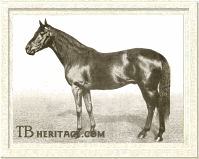
Robert le Diable
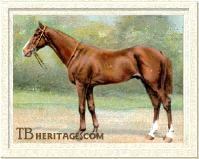
Traquair
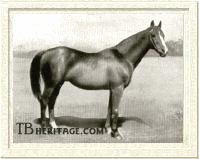
Ayr Laddie
| |
Ayrshire's best racing son was probably Robert le Diable, a beautifully bred colt though somewhat of an underachiever on the racetrack. Robert le Diable was out of the Melton mare Rose Bay, and his second dam was a full sister to Bend Or. Despite this wonderful pedigree, Robert le Diable possessed only average ability as a runner. He finished far down the course in Ard Patrick's Derby, but later managed wins in the City and Suburban Handicap, the Doncaster Cup, and the Duke of York Stakes. At stud, Robert le Diable produced a good son in Wrack, who was imported to the United States for stud duty and came up with thirty stakes winners, including Petee-Wrack and Flambino, later the dam of Triple Crown champion Omaha.
A few sons of Ayrshire perpetuated his male line for a while. Festino (1902), out of top class broodmare Festa, by St. Simon, was a winner of the Grosser Preis von Berlin, the Union Renen, and other important races in Germany, and later was a decent sire there.
Traquair (1904), out of the excellent race mare and producer Chelandry, won the Woodcote Stakes, July Stakes and Coventry Stakes, among other races, but later went wrong in the wind. He was sent to stud in Australia, where he became a very good sire, damsire of Powerscourt and also sire of the fast Woorak who later was a good sire. Another son who made a mark in Australia was Ayr Laddie (1892), out of the Sterling mare, Catherine Douglas, who was purchased as a yearling to Australia where he was an unsuccessful racehorse. Towards the end of his life, however, he rose in the sire ranks, and became champion sire in the year of his death in 1913.
Symington (1893), out of Syphonia, by St. Simon, was a moderately successful sire, his most notable contribution to the breed being his daughter Scotch Gift, the dam of the speedy colt and influential sire Tetratema. Chili II, out of Chelys, by Sir Visto, made a very good sire after his exportation to Argentina.
|
Other good colts sired by Ayrshire included Airship, Cossack, Doctrine, Airlie, and Heir Male.
Ayrshire's two classic winners were fillies: Our Lassie and Airs and Graces, both winners of the Oaks Stakes. Some of the more distinguished daughters of Ayrshire both on the track and in the breeding shed included: |
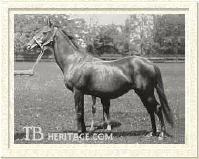
Glare, an influential broodmare | |
GLARE (1891), out of Footlight, by Cremorne. She was a good juvenile, winning the Brocklesby Stakes at Lincoln, Newmarket's Bedford Stakes and Buckenham Stakes, and the top-class Fern Hill Stakes at Ascot, and ran second three times in important events. She became the dam of the stakes winning full sisters Flair and Lesbia, both by St. Frusquin. Flair captured the Middle Park Plate and the One Thousand Guineas, while Lesbia took also took the Middle Park Plate as well as the Coronation Stakes. Flair was the second dam of Night Raid, the sire of Australian champion Phar Lap. A half sister, Lady Lightfoot, by Isinglass out of Glare, became the dam of Prince Palatine, winner of the St. Leger, Eclipse Stakes and twice the Ascot Gold Cup.
|
GAS (1892), out of Illuminata, by Rosicrucian, had some ability, as she finished third in the One Thousand Guineas. She was the dam of a Derby winner, Cicero, a colt by Cyllene. Her daughter Valve, by Velasquez, was herself the dam of a classic winner, Vaucluse, a Dark Ronald filly which captured the One Thousand Guineas.
AIRS AND GRACES (1895), out of Lady Alwyne, by Camballo was bred by the Duke of Portland. In training as a juvenile, the Duke thought the filly might be developing wind trouble, and so sold her to a Mr. Jones from Australia. A year later, Airs and Graces won the Oaks in the colors of her new owner and finished second in the One Thousand Guineas. A few years later, the Duke of Portland visited breeder Edmund Blanc at his stud farm in France, and who should be there but Airs and Graces. Blanc had purchased her from Jones and from her bred Jardy, by Flying Fox. Jardy won several French stakes races as well as the Middle Park Plate. Jardy also finished second to Cicero in the Derby at Epsom. |
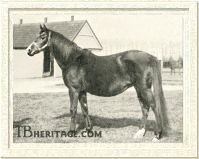
Gas, dam of Derby winner Cicero | | 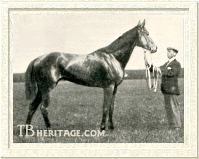
Oaks winner Our Lassie |
CANNIE LASSIE (1898), out of Wise Girl, by Wisdom, was the dam of the filly Witch Elm, a daughter of Orme bred by Col. William Hall Walker, later Lord Wavertree. Witch Elm was a victress in the Cheveley Park Stakes at two and the One Thousand Guineas Stakes at three.
BALLANTRAE (1899), out of Abeyance, by Touchet. This filly was later imported to the United States by William Collins Whitney. In his colors, she took the Cambridgeshire Handicap, and as a matron, she has had considerable influence, as she founded a family that boasts such members as American champions Equipoise and Seabiscuit, as well as French classic winner and leading sire Djebel.
DOCTRINE (1899), out of Axiom, by Wisdom, was a winner of the Coronation Stakes. As a broodmare, she produced the Sundridge filly Sun Worship, destined to become the dam of St. Leger and Ascot Gold Cup champion and leading sire Solario.
OUR LASSIE (1900), out of Yours, by Melton, was Ayrshire's second classic winner, as she too, captured the Oaks. Through daughter Lady Brilliant, was tail-female ancestress of the great race filly Imprudence (1944), winner of the Oaks and One Thousand Guineas Stakes in England, and of the French One Thousand Guineas. Also through Lady Brilliant, grandam of the great producer Black Ray, dam of Foray, Jacopo and Eclair, the latter dam of the important sire Khaled.
SKYSCRAPER (1900), out of Chelandry, by Goldfinch, captured the Cheveley Park Stakes and finished third in the One Thousand Guineas, Oaks, and Coronation Stakes. Tail-female ancestress of 1939 Oaks and One Thousand Guineas winner Galatea, and of Atalanta, the excellent American race mare of the 1950s by Count Fleet, and of the top '50s U.S. handicap horse, Reneged.. For a while she was celebrated as the paddock mate of the mighty mare Sceptre when that champion was boarded at Egerton House Stud.
JEAN'S FOLLY (1901), out of Black Cherry, by Bendigo, was the dam of the Gallinule colt Night Hawk, winner of the St. Leger. Tail-female ancestress of the French champion and top sire, Caro, the top Argentinian race horse Filon, Belmont Stakes winner Sherluck, and the top American handicap horse Grey Monarch.
INSPIRATION (1902), out of Sister Mary, by Woodlands. Imported as a broodmare to the United States, she produced the champion filly Startle, winner of the Kentucky Oaks, and Skeptic, who finished second in the Belmont Stakes. She is tail-female ancestress of Nantallah and other good racehorses in the U.S.
ROSE OF AYRSHIRE (1905), out of Pink Flower, became the dam of Roseway, a filly by Stornoway. Roseway captured the One Thousand Guineas and was second in the Oaks. A year later, Roseway's full sister, Roselet, finished third in the Oaks.
During his long career at Egerton House, Ayrshire shared the stallion accommodations at one time or another with the likes of Cyllene and St. Serf, a St. Simon stallion that was a half-brother to Atalanta. Ayrshire lived to the age of 25, when he was put down on March 30, 1910. The Duke of Portland gave his skeleton to the Natural History Museum in South Kensington.
--by Liz Martiniak
|
|
|
|

